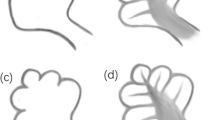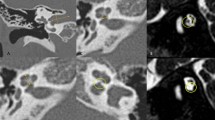Abstract
The objective of this study was to clarify the cause of the air–bone gap in incomplete partition (IP) type III cases according to the POU3F4 gene (DFNX2) mutation type. A retrospective analysis of patient medical records was done in a tertiary referral medical center. Five IP type III patients proved to be carrying a mutation in or affecting POU3F4. The hearing and the middle ear status at either exploratory tympanotomy or cochlear implantation from these DFNX2 cases was reviewed. Four of five unrelated IP type III patients harbored a point mutation of POU3F4 and the fifth patient carried a large genomic deletion upstream to POU3F4. Two of the four DFNX2 patients carrying a point mutation had moderate to severe mixed hearing loss with a substantial amount of air–bone gap. These patients underwent exploratory tympanotomy to identify the cause of their hearing loss. The other three patients, including one carrying a large deletion, had profound hearing loss at presentation and received a cochlear implant. In the exploratory tympanotomy group with a substantial amount of air–bone gap and a point mutation (n = 2), one patient had a perfect ossicular chain with normal mobility, a positive ipsilateral stapedial reflex, and a positive round window reflex. In the cochlear implantation group (n = 3), we found a stapes with normal mobility and a positive round window reflex in one patient who harbored a large genomic deletion upstream to POU3F4. We concluded that the probable presence of the third window effect is not limited to the particular type of POU3F4 mutation.




Similar content being viewed by others
References
Jansen S (1969) Malformation of the inner ear in deaf children. Acta Radiol 286:S1–S97
Nance WE, Setleff R, McLeod A et al (1971) X-linked mixed deafness with congenital fixation of the stapedial footplate and perilymphatic gusher. Birth Defects Orig Artic Ser 07:64–69
Glasscock ME (1973) The stapes gusher. Arch Otolaryngol 98:82–91
Jensen J, Terkildsen K, Thomsen KA (1977) Inner ear malformations with oto-liquorrhea tomographic findings in three cases with a mixed hearing impairment. Arch Otorhinolaryngol 214:271–282
Phelps PD, Reardon W, Pembrey M et al (1991) X-linked deafness, stapes gushers and a distinctive defect of the inner ear. Neuroradiology 33:326–330
Sennaroglu L, Sarac S, Ergin T (2006) Surgical results of cochlear implantation in malformed cochlea. Otol Neurotol 27:615–623
Cremers CW, Snik AF, Huygen PL et al (2002) X-linked mixed deafness syndrome with congenital fixation of the stapedial footplate and perilymphatic gusher (DFN3). Adv Otorhinolaryngol 61:161–167
Merchant SN, Rosowski JJ (2008) Conductive hearing loss caused by third window lesions of the inner ear. Otol Neurotol 29:282–289
Snik AF, Hombergen GC, Mylanus EA et al (1995) Air–bone gap in patients with X-linked stapes gusher syndrome. Am J Otol 16:241–246
de Kok YJ, van der Maarel SM, Bitner-Glindzicz M et al (1995) Association between X-linked mixed deafness and mutations in the POU domain gene POU3F4. Science 267:685–688
Huber I, Bitner-Glindzicz M, de Kok YJ et al (1994) X-linked mixed deafness (DFN3): cloning and characterization of the critical region allows the identification of novel microdeletions. Hum Mol Genet 3:1151–1154
Lee HK, Lee SH, Lee KY et al (2009) Novel POU3F4 mutations and clinical features of DFN3 patients with cochlear implants. Clin Genet 75:572–575
Cremers CW (1985) Audiologic features of the X-linked progressive mixed deafness syndrome with perilymphatic gusher during stapes gusher. Am J Otol 6:243–246
Cremers CW, Hombergen GC, Scaf JJ et al (1985) X-linked progressive mixed deafness with perilymphatic gusher during stapes surgery. Arch Otolaryngol 111:249–254
de Kok YJ, Vossenaar ER, Cremers CW et al (1996) Identification of a hot spot for microdeletions in patients with X-linked deafness type 3 (DFN3) 900 kb proximal to the DFN3 gene POU3F4. Hum Mol Genet 5:1229–1235
Incesulu A, Adapinar B, Kecik C (2008) Cochlear implantation in cases with incomplete partition type III (X-linked anomaly). Eur Arch Otorhinolaryngol 265:1425–1430
Acknowledgments
This work was supported by the Korea Healthcare Technology R&D Project, Ministry for Health, Welfare and Family Affairs, Republic of Korea, Grant A080588 and A111377, and by the Seoul National University Bundang Hospital Research Fund 04-2010-003 (to B.Y. Choi). The authors declare that they have no conflict of interest.
Author information
Authors and Affiliations
Corresponding author
Rights and permissions
About this article
Cite this article
Choi, B.Y., An, YH., Park, J.H. et al. Audiological and surgical evidence for the presence of a third window effect for the conductive hearing loss in DFNX2 deafness irrespective of types of mutations. Eur Arch Otorhinolaryngol 270, 3057–3062 (2013). https://doi.org/10.1007/s00405-013-2386-3
Received:
Accepted:
Published:
Issue Date:
DOI: https://doi.org/10.1007/s00405-013-2386-3




